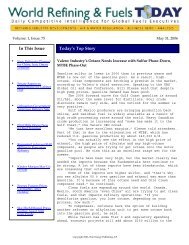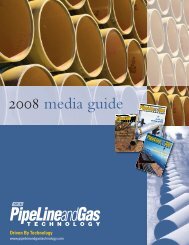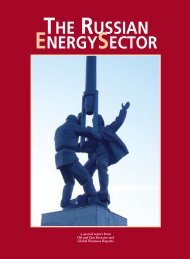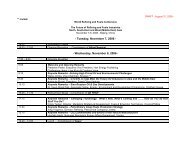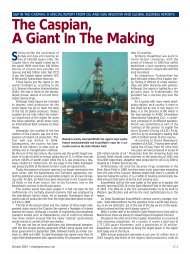ASTM: Gasoline Today and Tomorrow – An Executive Report
ASTM: Gasoline Today and Tomorrow – An Executive Report
ASTM: Gasoline Today and Tomorrow – An Executive Report
You also want an ePaper? Increase the reach of your titles
YUMPU automatically turns print PDFs into web optimized ePapers that Google loves.
Octane Week | <strong>ASTM</strong>: <strong>Gasoline</strong> <strong>Today</strong> <strong>and</strong> <strong>Tomorrow</strong> - <strong>An</strong> <strong>Executive</strong> <strong>Report</strong><br />
<strong>ASTM</strong> Issues Ethanol Sulfate Test Method Ballots<br />
This story appeared on October 23, 2006.<br />
<strong>ASTM</strong> members are considering three ballots,<br />
each proposing a different test method in support of the<br />
4 ppm sulfate limit recently added to D-4806, <strong>ASTM</strong>ʼs<br />
denatured fuel ethanol specification. If one or more<br />
of the test methods is acceptable, fuel providers will<br />
have solved a difficult issue that threatened to divide<br />
the subcommittee's ethanol, refiner <strong>and</strong> auto company<br />
representatives.<br />
The methods - two ion chromatography (IC)<br />
procedures <strong>and</strong> a lead potentiometric titration method -<br />
have been round-robin tested twice, <strong>and</strong> the latest results<br />
are solid, sources close to the effort told Octane Week.<br />
The goal is to have <strong>ASTM</strong> D0.2 Committee <strong>and</strong><br />
subcommittee members review the latest data, <strong>and</strong><br />
if negative votes are cast, “adjudicate” them using<br />
<strong>ASTM</strong>ʼs mediation process prior to the <strong>ASTM</strong> winter<br />
meeting, which begins Dec. 4.<br />
<strong>ASTM</strong>ʼs D02 Committee on Petroleum Fuels<br />
issued numerous ballots Friday afternoon. A quick<br />
scan prior to Octane Weekʼs press time indicated two of<br />
the three methods <strong>–</strong> potentiometric titration <strong>and</strong> direct<br />
injection IC <strong>–</strong> were included among the ballots. The<br />
st<strong>and</strong>ard is to be published next month. The balloting<br />
will close Nov. 20.<br />
Subcommittee members are feeling pressure<br />
to complete the st<strong>and</strong>ard-setting process. Sulfate<br />
contamination can cause filter plugging in the fuel<br />
distribution system <strong>and</strong> in vehicle fuel injectors. That was<br />
the case in 2003, when widespread vehicle fuel injector<br />
plugging was reported. The events triggered the start of<br />
the ethanol sulfate debate within D02.A a year later.<br />
Despite the need to limit fuel sulfate content, it<br />
took more than another year of delicate negotiations to<br />
bring D02.A subcommittee members into agreement on<br />
the appropriate level. After much debate, subcommittee<br />
members voted last June to approve the 4 ppm sulfur<br />
limit, overcoming limited support for a 1 ppm st<strong>and</strong>ard.<br />
At the time of the vote, test method data was<br />
lacking. It was expected that an <strong>ASTM</strong> Inter Laboratory<br />
Study (ILS) conducted prior to the meeting would have<br />
provided results demonstrating the adequacy of one or<br />
more of the test methods. Instead, the ILS failed because<br />
of sample-related problems. Sodium sulfate precipitated<br />
out of the samples, <strong>and</strong> test results were not useful.<br />
A second round robin was conducted this summer.<br />
This latest round robin included a sample composition<br />
that solved the earlier problem <strong>and</strong> an oxidation step<br />
in the IC methods to convert any sulfate that may have<br />
been reduced over time back to sulfate.<br />
This time around, both the aqueous injection <strong>and</strong><br />
direct injection IC methods produced “good data” from<br />
a dozen or so participants, a source familiar with the<br />
round robin told Octane Week.<br />
The lead titration method, which did not include an<br />
oxidation step, also produced “very good results from<br />
about 10 participants.”<br />
Some 21 labs participated in the direct injection IC<br />
tests, the source said. “The statistician tried to pool the<br />
data <strong>and</strong> could not get convergence. Instead, there was<br />
a bimodal result.”<br />
The two leading IC devices, manufactured by<br />
Metrohm <strong>and</strong> Dionex, use different column suppression<br />
configurations (tri-chamber <strong>and</strong> continuous), <strong>and</strong> that<br />
may account for the majority of difference in results.<br />
“The instruments are different <strong>and</strong> give different<br />
responses. Both are in use, so there is an effort to get<br />
an idea of how the results will appear so that both<br />
instruments will be allowed in the test method with<br />
their own precision statements,” our source told us.<br />
The precision correlation was reworked <strong>and</strong> now<br />
there is “different but good convergence for each of the<br />
two suppressor configurationsʼ data.”<br />
Ballots for the aqueous injection IC method <strong>and</strong><br />
the potentiometric titration method were submitted to<br />
<strong>ASTM</strong> in September. <strong>ASTM</strong> also extended the ballot<br />
deadline so ILS leaders could submit the revised<br />
direct injection IC method for ballot. That method will<br />
have two precision statements for the two types of IC<br />
suppression configurations that were tested.<br />
“From the results of our round robin, I am fully<br />
confident any of the three methods will support the 4<br />
ppm sulfate specification. They all will also support a 1<br />
ppm specification,” he said.<br />
That doesnʼt mean the test method ballots will pass<br />
easily, <strong>ASTM</strong> sources warn. If the negatives cannot be<br />
adjudicated successfully, the ballot could fail in December.<br />
In that event, the methods would need to be reworked to<br />
address the negatives <strong>and</strong> reballoted in the spring.<br />
14 February 2007







